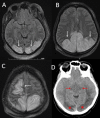Case Report: A Fatal Case of Malignant Posterior Reversible Encephalopathy Syndrome in the Setting of Diabetic Ketoacidosis
- PMID: 37842403
- PMCID: PMC10576405
- DOI: 10.7759/cureus.45218
Case Report: A Fatal Case of Malignant Posterior Reversible Encephalopathy Syndrome in the Setting of Diabetic Ketoacidosis
Abstract
Posterior reversible encephalopathy syndrome (PRES) is a clinicoradiological syndrome that typically presents with headache, visual disturbances, seizures, and altered consciousness. Its hallmark radiological features involve subcortical white matter lesions on magnetic resonance imaging (MRI), predominantly in the parietal and occipital lobes. While generally reversible with favorable outcomes, a minority of cases may progress to malignant cerebral edema and herniation, resulting in death. We present an unusual case of a 47-year-old woman who developed malignant PRES associated with severe diabetic ketoacidosis (DKA). Despite aggressive medical and surgical treatments, the patient's condition worsened, indicating the potential for devastating outcomes in malignant PRES. This case adds to the limited body of literature that suggests the need for vigilance in monitoring patients with severe glycemic disturbances for neurological complications, such as PRES. It also highlights the importance of early recognition and aggressive management in improving neurological outcomes in malignant PRES. Further research is warranted to understand the underlying mechanisms better and identify optimal treatment strategies for this rare but potentially life-threatening condition.
Keywords: case report; diabetic ketoacidosis; dka; posterior reversible encephalopathy syndrome; pres.
Copyright © 2023, Rodriguez et al.
Conflict of interest statement
The authors have declared that no competing interests exist.
Figures



Similar articles
-
Posterior reversible encephalopathy syndrome with spinal cord involvement (PRES-SCI) as a rare complication of severe diabetic ketoacidosis: a case report and review of the literature.Childs Nerv Syst. 2018 Apr;34(4):701-705. doi: 10.1007/s00381-018-3724-y. Epub 2018 Jan 12. Childs Nerv Syst. 2018. PMID: 29330587 Review.
-
Unveiling the Hidden Culprit of Posterior Reversible Encephalopathy Syndrome Superimposing Postpartum Eclampsia: A Rare Case.Cureus. 2024 Mar 26;16(3):e57006. doi: 10.7759/cureus.57006. eCollection 2024 Mar. Cureus. 2024. PMID: 38681382 Free PMC article.
-
Clinical and Radiological Features of Unilateral Posterior Reversible Encephalopathy Syndrome (PRES): A Case Report.Cureus. 2024 Apr 22;16(4):e58774. doi: 10.7759/cureus.58774. eCollection 2024 Apr. Cureus. 2024. PMID: 38784364 Free PMC article.
-
Acute Obstructive Hydrocephalus Due to Posterior Reversible Encephalopathy Syndrome Successfully Treated With Continuous Ventricular Drainage: A Case Report.Cureus. 2025 Mar 18;17(3):e80803. doi: 10.7759/cureus.80803. eCollection 2025 Mar. Cureus. 2025. PMID: 40255820 Free PMC article.
-
Posterior Reversible Leucoencephalopathy Syndrome: Case Series, Comments, and Diagnostic Dilemma.Curr Neurol Neurosci Rep. 2023 Aug;23(8):433-449. doi: 10.1007/s11910-023-01281-3. Epub 2023 Jun 28. Curr Neurol Neurosci Rep. 2023. PMID: 37378723 Review.
References
-
- Posterior reversible encephalopathy syndrome (PRES): diagnosis and management. Triplett JD, Kutlubaev MA, Kermode AG, Hardy T. Pract Neurol. 2022;22:183–189. - PubMed
-
- Management and outcomes of malignant posterior reversible encephalopathy syndrome. Akins PT, Axelrod Y, Silverthorn JW, Guppy K, Banerjee A, Hawk MW. Clin Neurol Neurosurg. 2014;125:52–57. - PubMed
-
- Posterior reversible encephalopathy syndrome: clinical and radiological manifestations, pathophysiology, and outstanding questions. Fugate JE, Rabinstein AA. Lancet Neurol. 2015;14:914–925. - PubMed
Publication types
LinkOut - more resources
Full Text Sources
